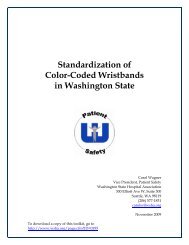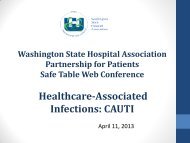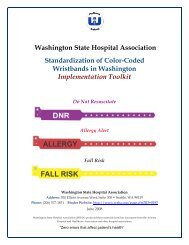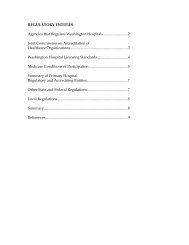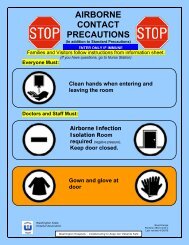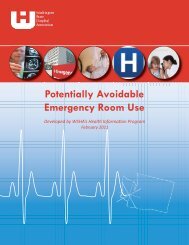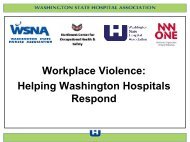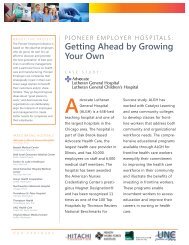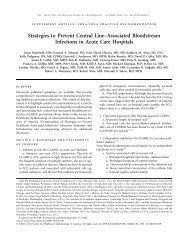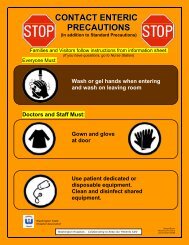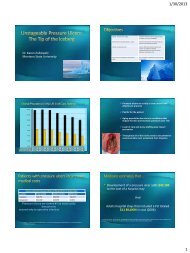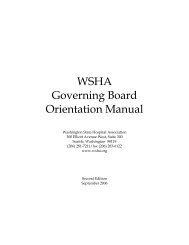NSQI - Washington State Hospital Association
NSQI - Washington State Hospital Association
NSQI - Washington State Hospital Association
- No tags were found...
Create successful ePaper yourself
Turn your PDF publications into a flip-book with our unique Google optimized e-Paper software.
Nurse Sensitive Outcome Indicators:What They Are and How They AreMeasured and BenchmarkedHosted By:The <strong>Washington</strong> <strong>State</strong>,Ruckelshaus Nurse Staffing SteeringCommittee© CALNOC October 2008: All rights reserved1
• Gladys Campbell, RN,MSN, ExecutiveDirector, NorthwestOrganization of NurseExecutives• Mary Foley, RN, MS,PhD(c), AssociateDirector, Center forNursing Research &Innovation, UCSFSchool of NursingPresenters
Background Information• History: Legislative Concerns• Goal: Collaborative work on nurse staffing,including nurse sensitive outcome indicators• Parties to the process:– SEIU 1199 Healthcare– United Staff Nurses Union 141 UFCW– <strong>Washington</strong> <strong>State</strong> Nurses <strong>Association</strong>– <strong>Washington</strong> <strong>State</strong> <strong>Hospital</strong> <strong>Association</strong>– Northwest Organization of Nurse Executives
Legislation• <strong>Hospital</strong> Based Nurse StaffingCommittees– Composition – at least 50% bedsidestaff nurses– Create nurse staffing plans– Staffing plans reviewed and accepted orrejected by the CEO– Post staffing plans
Memorandum of Agreement• Report staffing as part of adverse eventreporting (this is now a regulation)• Collection of data on Nurse Sensitive QualityIndicators (<strong>NSQI</strong>)• Survey what indicators hospitals arecollecting• Identify and collect data on at least five <strong>NSQI</strong>to be collected by <strong>Washington</strong> hospitals andshared with their staffing committees
<strong>Washington</strong> <strong>State</strong>:Nurse Sensitive QualityIndicators• Falls• Falls with injury• Pressure ulcers• Nursing hours per patient day• Skill mix
Reporting• National Database of Nursing QualityIndicators• Collaborative Alliance for NursingOutcomes• <strong>Washington</strong> <strong>State</strong> <strong>Hospital</strong> <strong>Association</strong>
NURSING SENSITIVE QUALITYINDICATORS: THE ORIGIN8
Professional Nursingand the Origin of Evidence9
Documenting NursingEffectiveness• Florence Nightingale, founder ofmodern nursing was a visionary• What Florence Nightingale wasdocumenting in the 1800s we are stilltrying to prove: Nurses make adifference in patients, families, andcommunities10
Florence Nightingale Made Changes, and Kept Records, to Document CareImprovements at Scatari, 1855Death rate peaked in February 1855 at mortality rate of 43% of cases treated.Reforms began in March and within 6 months the mortality rate was 2% 11Source: Cohen, Florence Nightingale. Scientific American 250(3) March 1984.
What Is the History of NurseSensitive Quality Indicators?• In 1994, The American Nurses <strong>Association</strong>(ANA) started a long-term commitment toestablish that patient care (quality andsafety) was linked to nursing care.• The purpose of this work was to educatenurses, consumers, and policy makers aboutnursing’s contribution to inpatient hospitalcare.12
The Nursing Care Report Cardfor Acute Care, 1995• The ANA commissioned a study todetermine the nature and strength of thelinkages and eventually the first list ofpossible indicators was narrowed fromover 100, to 71, 21, and ultimately, to 11nursing quality indicators.• Pilot tests were conducted in 1996(CALNOC was one of the pilots,conducted in California) to test the 11indicators.14
The Agency for HealthQuality ResearchAHRQ fundedresearch thatfurther promotedthe connectionbetween nursestaffing, nurseworkenvironments, andsafe patient care
IOM Report Specific toNursing• Released in 2004• Organizationalculture shouldreflect a safeenvironment toencourage thereporting of errors,analysis, andprevention
What Does “Nurse Sensitive”Mean?• Nurse sensitive quality outcomes arethose patient outcomes that have beenfound, by clinical research, to beuniquely linked to the presence orabsence of nursing care.20
NURSING SENSITIVE QUALITYINDICATORS: DEFINITIONS OFTHE INDICATORS21
National Quality Forum (NQF)-endorsedNursing-Sensitive MeasuresPurpose – to promote highest quality andoutcomesCurrently there are 15 Nurse SensitiveIndicators:1. Failure to rescue2. Pressure ulcer prevalence3. Falls4. Falls with injury5. Restraint (vest and limb) prevalence22
NQF-endorsed Nursing-Sensitive Measures cont.6. Urinary catheter-associated associated UTI (ICU)7. Ventilator-associated associated pneumonia (ICU)8. Central line catheter-associatedassociated BSIs (ICU)9. Smoking cessation counseling for AMI10. Smoking cessation counseling for heartfailure11. Smoking cessation counseling forpneumonia23
NQF-endorsed Nursing-Sensitive Measures12. Skill Mix13. Nursing care hours per patient day14. Practice Environment Scale-Nursing Work15. Voluntary Turnover24
Quality of Care: How is itDefined*• By Structure- resource use orcharacteristics of the environment• By Process- the tools and activitiesused to improve care (think of riskassessments, admission data bases)• By Outcomes- Benefits to the patient*Defined by Donabedian, , 198025
Skill Mix and PatientCare Hours- Examplesof Structural Measures26
Nursing StaffingCharacteristics• Total nursing hoursper patient day(HPPD) RN HPPD LPN HPPD UAP HPPD• Skill Mix• % Agency Hours• Turnover Rate National QualityForum Magnet• Job Satisfaction• RN Characteristics Education Certification Years of Experience27
Nursing Staffing CharacteristicsProblems exist in the measurement andbenchmarking of nursing hours per patientday (NHHP) secondary to a lack ofconsistency in definition of terms, and a lackof consistency in “who” is included in thehours – including:• Fixed and Variable FTE• Direct and Indirect Nursing Hours• Productive and NonproductiveNursing Hours28
Case Study – Analyzing LaborProductivity Case Against Study the BudgetYour staff are complaining that they are overworked.They tell you they don’t get breaks, can’t accomplishtheir tasks and need more staff. What you see on yourdaily rounds validates this… in fact you are worriedthat the staffing may be unsafe. As you fill out yourrequisition to post for a new position you notice thatyour Budgeted HRS/UOS are 25.24 and yet the actualHRS/UOS are 27.2. When you turn in your requisitionfor additional staff this request is rejected by yourmanager and you are told you cannot have more staffas you are already over budget. What’s wrong??
Example Score BoardHaving the Data to Analyze theProblem… Analysis of VarianceBudgeted HRS/UOS –Fixed Hours25.24Actual HRS/UOS –27.2Variable HoursTotal HoursTotal HoursDirect HoursNonproductiveHours(Benefit Time)Indirect Education HoursHours(nonproductive)(educationtime etc.)Budgeted3.7Actual5.5Budgeted21.54Actual21.7Budgeted18Actual16Budgeted3Actual5Budgeted.54Actual.70
Example Score BoardHaving the Data to Analyze theProblem… Analysis of VarianceBudgeted HRS/UOS –Fixed Hours25.24Actual HRS/UOS –27.2Variable HoursTotal HoursTotal HoursDirect HoursNonproductiveHours(Benefit Time)Indirect Education HoursHours(nonproductive)(educationtime etc.)Budgeted3.7Actual5.5Budgeted21.54Actual21.7Budgeted18Actual16Budgeted3Actual5Budgeted.54Actual.70
<strong>Hospital</strong> AcquiredPressure Ulcers-An Outcome Measure32
<strong>Hospital</strong> Acquired PressureUlcers• According to the National PressureUlcer Advisory Panel (NPUAP),Pressure Ulcers are measured byIncidence and Prevalence– Incidence is the rate of new ulcers in apopulation over time– Prevalence is the number of old and newcases at any one time (like a specific day)33
<strong>Hospital</strong> Acquired Pressure UlcerIndicatorDefinition:• Pressure Ulcers are measured as thepercent of patients with stage I, II, III, IVand Unstageable ulcers.• CALNOC collects both• Benchmarking is performed againstprevalence34
Falls=Outcomes35
Falls, and Falls with Injury• The concern is of course with patientinjury, but all falls in fact have a risk ofinjury• While the fall is an outcome measure,many process measures are employedto assess and mitigate risk36
There Are Steps That CanImprove Accuracy of ProcessMeasures• There are common nationaldefinitions• There are clearly defined andconsistent processes whenactivities are expected to beperformed• Reliable tools help make theactivities more comparable37
NURSING SENSITIVE QUALITYINDICATORS ARE ENDORSEDAS NATIONAL STANDARDS38
QUALITY—A A National FocusPresident’s s Advisory Commission on Consumer Protection and Quality in the Health39Care Industry Report (1998).
What is theNational Quality Forum?The mission of NQF is to improveAmerican healthcare through theendorsement of consensus-basedstandards for measurement and publicreporting of healthcare performance datathat provides meaningful informationabout whether care is safe, timely,beneficial, patient-centered, equitable,and efficient.40
NQF 2004The first 15 NursingSensitive Measuresundergo extensive review,evaluation, and consensusapproval42
NQF 2006As defined by NQF, thenumber of “never events” isnot known, but what isknown is that they result inmany deaths and additionalhealth care costs.Significant implications fornursing include the nonpaymentfor <strong>Hospital</strong>Acquired Pressure Ulcersand Falls (2 of the critical<strong>NSQI</strong> you will track)43
CMS Roadmap – Theultimate strategic goal –“The right care for everyperson every time.”
Centers for Medicare andMedicaid Services:Non-Payment for Never EventsCMS declares there should not bepayment for “never events,” likesurgery on the wrong body part ormismatched blood transfusion.
<strong>Washington</strong> <strong>State</strong> Focus• Adverse events reporting• Pledge Not to Bill for Never Events– <strong>Washington</strong> <strong>State</strong> <strong>Hospital</strong> <strong>Association</strong>,<strong>Washington</strong> <strong>State</strong> Medical <strong>Association</strong>,<strong>Washington</strong> <strong>Association</strong> of Ambulatory SurgeryCenters• Health Care Authority: Planning for Non-Payment for Never Events
Benchmarking with NurseSensitive Quality Indicators47
What is a “Benchmark”?• In non-health terms, it is a standard,norm, or “yard-stick” to judge one'sperformance as an individual orcompany.• It is a standard measurement or metricused to evaluate the performance ofany entity, from schools, to stockportfolios48
Benchmarking Reports• The purpose of a benchmarking reportin healthcare is to give a hospital, andyour committees, a succinct summaryof your own performance, together withthe performance of “like” hospitals• <strong>Hospital</strong> level data may be helpful tosenior leaders• Unit level data is most useful forclinicians and clinical leaders4949
Examples of BenchmarkingReports from the CALNOCData50
Staffing Effectiveness Report by Unit – MonthlyFalls per 1000 Pt Days with Percent Other (Unlicensed) Hours of CareFrom JANUARY 2007 To JULY 2008Unit Name: AOU52
CalNOC Falls Over TimeFalls per 1000 Patient DaysAll <strong>Hospital</strong>s Reporting1998-20054.504.00Performance by averages by type of unit3.50Falls per 1000 Patient Days3.002.502.001.501.000.500.00Q298Q398Q498Q199Q299Q399Q499Q100Q200Q300Q400Q101Q201Q201Q401Q102Q202Q302Q402Q103Q203Q303Q403Q104Q204Q304Q404Q105Q205QuarterMS CCU SD5353
QUESTIONS FOR THESTAFFING COMMITTEES:54
Seeking the Information YouWill Need• Where in your facility will you findinformation on staffing?• How is that information collected(hours/skill mix)?• How are patient days collected?• Who keeps the records for Falls?Pressure Ulcers?55
Part II:Nurse Sensitive QualityIndicators• Friday, June 19, 2009 (8:00 - 10:00 AM)• Topic: How Staffing Committees CanUse the Indicators to Measure StaffingEffectiveness• For connection information, go towww.wsha.org; click on “web casts”,then “View Connection Information”
Thank You for Participating!Questions?
Program Evaluation• At the end of this webcast we will beemailing you a survey so that you mayprovide us feedback on our presentersand the usefulness of this presentation.Thank You!



